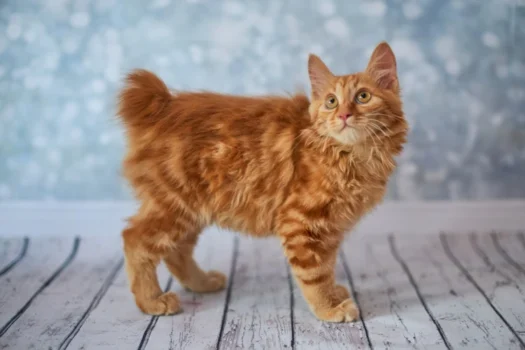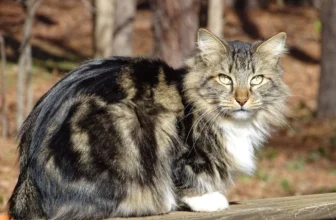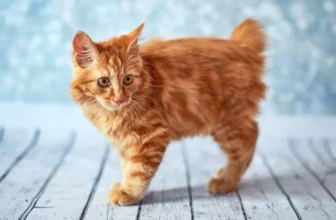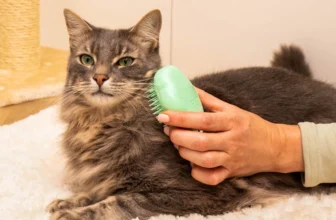Have you ever wondered why your American Bobtail seems to shed more than usual? Shedding is a natural process where cats release old, damaged fur to make way for new fur. However, excessive shedding can be a cause for concern, especially if stress is involved. As a loving pet owner, it’s essential to understand the relationship between stress and shedding in American Bobtails. In this article, we’ll dive into the science behind shedding, the role of hormones, and the impact of stress on your cat’s shedding. We’ll also provide practical tips to identify and reduce stress in your American Bobtail to keep them healthy and happy.
The Science Behind Shedding
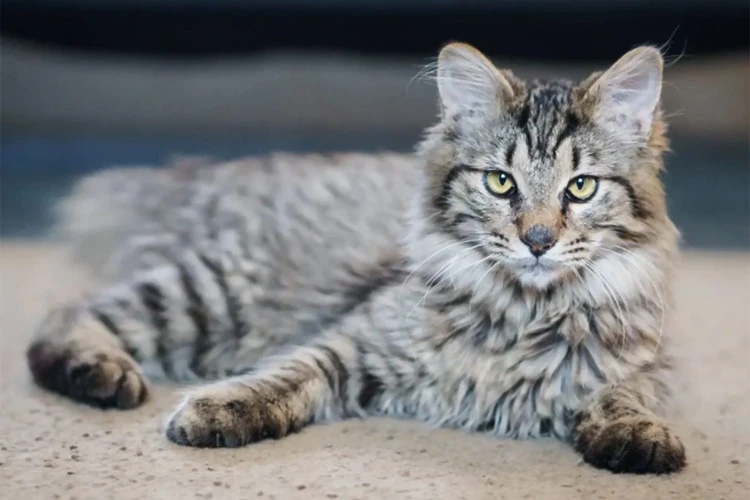
As pet owners, we are all too familiar with the shedding of our furry friends. But have you ever wondered about the science behind the shedding process in American Bobtail cats? Shedding is a natural phenomenon in which your cat’s old or dead hair falls out and is replaced by new hair growth. It’s essential for maintaining their coat’s health, but it can also be a hassle to manage. In this section, we will explore the details of the shedding process, including the role of hormones and factors that affect shedding. To learn more about the biology of American Bobtail shedding, please refer to our article: “All You Need to Know About the Biology of Shedding in American Bobtails.”
Understanding the Shedding Process
The process of shedding is a natural phenomenon that all cat breeds including the American Bobtail experience. Cats lose their hair to make room for new hair growth. This process ensures that their fur remains fresh and healthy. However, excessive shedding can be a sign of an underlying issue. Understanding the shedding process can be helpful in identifying problems related to shedding.
The American Bobtail breed sheds its fur throughout the year, with varying degrees of intensity depending on the seasons. Spring and fall are the primary shedding seasons, during which cats shed their coats to get rid of their winter or summer coats. During shedding, the cat’s outer layer falls out, including the damaged or dead hair shafts. The cat’s hair follicles then get stimulated, and new hair starts to grow in place of the fallen hair.
The shedding cycle of a cat can be divided into three phases:
- Anagen-phase: The anagen-phase is the growth phase of the cat’s fur. During this phase, the follicles start to produce new hair.
- Catagen-phase: The catagen-phase is a short phase where the hair follicles shrink from the growth phase and prepare for the resting phase.
- Telogen-phase: The telogen-phase is the resting phase, where the cat’s hair follicles are inactive. The hair that has been growing for several months ultimately falls out during this period.
Factors such as breed, age, sex, and environment can affect the shedding cycle of American Bobtail cats. It’s essential to learn about their shedding patterns to take better care of their coat and avoid complications caused by excessive shedding.
Understanding the science behind shedding can help pet owners take steps to reduce shedding and ensure their cat’s coat remains healthy and shiny. Some pet owners believe in certain shedding myths, but it’s important to separate fact from fiction. For example, shaving your cat’s coat won’t necessarily reduce shedding.
By understanding the different phases of shedding and the factors affecting the shedding process of American Bobtail cats, pet owners can identify problems such as excessive shedding and take steps to keep their cat’s coat healthy. Regular grooming, proper diet, and minimizing stress can all help reduce shedding. For more detailed information and tips on reducing shedding in American Bobtail cats, check out our article on tips to reduce shedding in American Bobtail cats.
The Role of Hormones
The Role of Hormones in American Bobtail shedding is crucial as it plays a significant part in the cat’s biological processes. Hormones are the body’s chemicals that signal and regulate different functions of the body. Hormones influence the shedding process in cats, and the increase or decrease in the levels of certain hormones can cause excessive shedding or loss of hair in cats.
Here are some hormones that play a vital role in the shedding process of American Bobtails :
- Thyroid Hormones: The thyroid gland regulates the cat’s metabolism, and any irregularity in the thyroid hormone levels can lead to excessive shedding.
- Melanocyte-Stimulating Hormone (MSH): This hormone is responsible for determining the color of the cat’s fur. It regulates the melanin production in the hair follicles and determines the type of hair that enters the growth phase.
- Progesterone and Estrogen Hormones: These hormones are female sex hormones and have a role in the shedding process in female American Bobtails. Increased levels of estrogen can cause excessive shedding.
- Cortisol Hormone: Cortisol is the stress hormone, and increased levels of this hormone can cause hair loss in cats. Stressful situations negatively affect the cortisol level, which may lead to excessive shedding in American Bobtails.
The imbalance or changes in these hormones can lead to several shedding problems in American Bobtails, such as hair thinning, balding, and shedding. However, some natural remedies can help regulate these hormone levels and prevent shedding issues. A healthy and balanced diet, regular grooming, and routine exercise can promote hormonal balance and reduce excessive shedding.
Hormones are essential in the shedding process of American Bobtails, and their role should never be overlooked. Hormonal imbalances can cause excessive shedding, and proper diet and grooming routines can help keep the hormone levels in check. Regular consultation with a veterinarian can also help identify and address any hormonal imbalance related to shedding in American Bobtails.
Factors Affecting Shedding
Shedding is a complex process that can be influenced by various factors, including health, nutrition, climate, genetics, and grooming habits. A healthy American Bobtail with a balanced diet and regular grooming will typically shed less than an unhealthy cat that lacks proper nutrition and grooming. Genetics play a crucial role in determining how much hair a cat will shed. Some breeds, such as the American Bobtail, are more prone to shedding due to their double coats.
Climate is another factor that can affect shedding. Cats living in colder climates will typically have a thicker coat, which will shed more during the summer months. Conversely, cats living in warmer climates may shed more during the winter months to prepare for the upcoming hot weather. However, cats with indoor access are less affected by these seasonal changes.
Grooming habits also play a significant role in shedding. Proper grooming can help remove excess hair and improve the overall health of a cat’s coat. Regular brushing can help distribute natural oils throughout the fur, which can prevent matting and tangling. It’s important to use high-quality grooming tools, such as a Furminator, to avoid damaging the cat’s coat or skin. However, several shedding myths exist that might make the shedding worse.
Finally, diet and nutrition are important factors that can affect shedding. A cat’s diet should be rich in protein and essential fatty acids to maintain healthy skin and coat. High-quality pet food is essential to providing the necessary nutrients for a healthy coat. The proper diet and supplements can significantly reduce the amount of shedding.
Understanding the various factors that can affect shedding is essential to maintaining a healthy coat for your American Bobtail. Regular grooming, proper nutrition, and a healthy lifestyle can significantly reduce the amount of shedding for your cat.
Stress and Shedding

As a cat owner, you may have noticed that your American Bobtail sheds quite a bit, especially during certain times of year. Shedding is a natural process by which cats lose old and damaged fur and regrow new, healthy fur. However, did you know that stress can also play a significant role in the shedding process of American Bobtails? Stress can affect a cat’s overall health and well-being, and can also lead to excessive shedding. In this section, we will explore the connection between stress and shedding in American Bobtails in more detail. Let’s dive in! If you need more information on shedding, check out our article on shedding myths or if you want to read about effective tools for managing shedding, check out our article on Furminator vs Regular Brush for American Bobtail Shedding.
What is Stress?
Stress is a normal physical and psychological response to a challenging or demanding situation. It can be a helpful response that allows the body to cope with challenging or risky situations, but it can also be harmful if it becomes chronic or unmanageable.
In cats, stress can manifest itself in a variety of ways, including aggression, inappropriate elimination, decreased appetite, and excessive grooming or shedding. Stress levels can vary depending on the cat’s individual temperament and environment, and some cats may be more prone to stress than others.
Common causes of stress in cats:
| Environmental factors | Changes in routine or location, lack of stimulation, overcrowding, or being kept in a small, confined space. |
| Health conditions | Chronic pain, illness, or injury. |
| Social factors | Conflict with other cats, unfamiliar or threatening animals, or loss of a companion. |
| Owner-related factors | Owner’s behavior or mood, lack of attention or affection, or disruption to the cat’s normal routine. |
It is important for cat owners to pay attention to their cat’s behavior and body language and to take steps to reduce stress when possible. Chronic stress can lead to health problems and should be addressed promptly.
How Stress Affects American Bobtail Shedding?
Stress can have a significant impact on American Bobtail shedding. When a cat is under stress, their body releases hormones such as cortisol which can disrupt the natural shedding cycle. This disruption can cause a cat to shed more frequently or excessively which can lead to bald spots and hair loss.
The effects of stress on American Bobtail shedding include:
- Increased shedding frequency: Cats under stress may shed more frequently than usual, which can result in large amounts of hair falling out across your home.
- Excessive shedding: The release of cortisol can lead to excessive shedding, which can result in bald spots and thinning fur.
- Changes in fur texture: The quality and texture of your cat’s fur may also be affected by stress, leading to dry, brittle or coarse fur.
- Skin irritation: Excessive shedding can cause irritation and inflammation of the skin, leading to further discomfort for your cat.
- Reduced grooming: Cats under stress may groom themselves less frequently, which can result in matted fur and tangles.
It’s important to note that not all cats will experience shedding in the same way. Some may be more susceptible to stress-related shedding than others. It is also important to note that excessive shedding or hair loss can be a sign of other health issues in your cat. If you notice your cat shedding excessively or have concerns about their shedding, it’s important to consult with a veterinarian for a proper diagnosis and treatment plan.
Physical Signs of Stress-Related Shedding
Stress is a major factor contributing to the shedding problems experienced by American Bobtails. When cats experience stress, their body releases a hormone called cortisone. Cortisone can cause a range of physical symptoms, including hair loss and thinning. Here are some physical signs that your American Bobtail may be experiencing stress-related shedding:
| Signs of Stress-Related Shedding | Description |
|---|---|
| Bald Patches | Stress can cause bald patches on your cat’s skin that may feel smooth or scaly to the touch. These patches may also be accompanied by redness, inflammation or irritation. |
| Excessive Shedding | If your cat is shedding more than usual or seems to be shedding year-round, stress may be the culprit. |
| Changes in Coat Texture or Quality | If your cat’s hair feels dry or brittle to the touch, stress could be a factor. Stress can affect the quality of your cat’s fur and make it appear less shiny, less healthy, or less soft than usual. |
| Behavior Changes | If you notice that your cat is more irritable or aggressive than usual, or if they seem to be avoiding interaction with family members, this could be a sign of stress. These behavioral changes can in turn lead to skin problems and excessive shedding. |
| Excessive Grooming | If your cat is constantly grooming themselves, they may be experiencing stress. Excessive grooming can lead to patches of thinning or balding hair on your cat’s body. |
If you notice any of these signs of stress-related shedding in your American Bobtail, it’s important to identify the underlying causes of stress and take steps to reduce it. This will help maintain your cat’s healthy coat, and overall well-being.
Identifying and Reducing Stress in American Bobtails
As a pet owner, it’s important to understand that stress can take a toll on your American Bobtail. Stress can not only affect your cat’s mental well-being but also their physical health, including leading to increased shedding. It’s essential to identify and reduce factors that can lead to stress in your American Bobtail’s life. In this section, we will discuss the signs of stress-related shedding, common causes of stress, and tips to help reduce stress in your American Bobtail’s life. By taking simple steps to alleviate stress, you can help your cat lead a happier and healthier life.
Common Causes of Stress in American Bobtails
Stress can be brought about by many different factors in American Bobtails, and it is important for cat owners to be aware of these common causes to prevent their cats from getting stressed. Here are some common causes of stress in American Bobtails:
| Factor | Description |
|---|---|
| Environmental changes | American Bobtails are creatures of habit, and sudden environmental changes such as moving houses, rearranging furniture, or introducing new pets can cause them to feel anxious and stressed. |
| Health issues | Illness, injury, and chronic health conditions can cause American Bobtails to feel stressed and anxious. It is important to ensure that your cat has regular check-ups with a vet to address any health issues. |
| Uncomfortable surroundings | American Bobtails require a comfortable and safe environment to feel secure. Dirty litter boxes, lack of perches or hiding spots, loud noises, or bright lights can cause your cat to feel uncomfortable and stressed. |
| Separation anxiety | Similar to dogs, American Bobtails can also experience separation anxiety when their owners leave the house. This can cause them to become stressed, leading to behaviors such as excessive meowing, scratching, and destructive behavior. |
| Lack of mental and physical stimulation | American Bobtails are highly intelligent and active cats, and lack of mental and physical stimulation can cause them to become bored, frustrated and stressed. Providing your cat with interactive toys and engaging in playtime with your cat can help reduce stress. |
It is important to keep in mind that each American Bobtail is unique and may have different triggers when it comes to stress. By identifying and addressing these common stressors, cat owners can help reduce their cats’ stress levels and minimize shedding caused by stress.
Tips to Reduce Stress in Your Cat’s Life
Reducing stress in your American Bobtail’s life can help alleviate shedding and improve their overall health and happiness. Here are some helpful tips to keep your feline’s stress levels in check:
- Create a Safe Space: Designate a quiet and comfortable area in your home where your cat can retreat to when feeling overwhelmed or anxious. Make sure they have access to their favorite toys and bedding.
- Stick to a Routine: Cats thrive on consistency, so try to maintain a regular feeding and playtime schedule. This helps them feel secure and reduces the likelihood of stress-inducing surprises or changes.
- Provide Mental Stimulation: Boredom can be a major source of stress for cats, so make sure to provide plenty of toys, scratching posts, and interactive puzzles to keep their minds engaged and active.
- Regular Vet Check-ups: Taking your American Bobtail to the vet for regular check-ups can help identify and address any underlying health issues that may be contributing to their stress.
- Use Pheromone Sprays: Certain pheromone sprays, like Feliway, can help reduce anxiety and promote relaxation in cats. You can spray these products in your cat’s designated safe space or on their bedding.
By implementing these tips, you can create a healthy and stress-free environment for your American Bobtail, which can lead to less shedding and a happier, more contented cat.
When to Consult a Vet?
The shedding process in American Bobtails can be influenced by various factors, including stress levels. While some shedding is normal, excessive shedding can be a sign of an underlying health issue.
So, when should you consult a vet?
| Situation | Action |
| The shedding is excessive or abnormal | Contact your vet to rule out any underlying health issues |
| Your cat is showing other symptoms like lethargy, loss of appetite, or vomiting | Contact your vet immediately as these can be signs of a serious illness |
| You have tried reducing your cat’s stress levels and the shedding persists | Contact your vet to explore other possible solutions or treatments |
While it’s important to keep an eye on your American Bobtail’s shedding, it’s equally important to pay attention to any other symptoms they may be experiencing. By consulting a vet when necessary, you can ensure that your feline friend stays healthy and happy.
Conclusion
In conclusion, shedding is a natural process for American Bobtails, but excessive shedding can be a cause for concern. Stress is a major contributing factor to excessive shedding, and it is essential for pet owners to understand the physical signs of stress and take necessary measures to reduce it in their cats’ lives.
By understanding the shedding process and its underlying biology, pet owners can take proactive steps to keep their cats healthy and happy. Hormones, diet, and other environmental factors play a role in shedding, and pet owners should strive to maintain a healthy diet and a low-stress environment for their cats.
To reduce stress in their cats’ lives, pet owners can try various techniques such as interactive playtime, providing plenty of toys, and creating a designated safe and cozy space in their homes. It is important to consult a veterinarian if a cat’s excessive shedding persists or is accompanied by other symptoms such as lethargy or loss of appetite.
In conclusion, with careful attention to a cat’s environment and stress levels, pet owners can promote healthy shedding patterns and help maintain their American Bobtail’s overall health and well-being.
Frequently Asked Questions
Why do American Bobtails shed?
American Bobtails shed as a natural process of hair growth and replacement. Regular shedding helps to maintain healthy skin and fur coat.
Can shedding be prevented?
No, shedding is a natural process and cannot be prevented. However, proper grooming and care can minimize the amount of shedding.
What factors contribute to shedding?
Factors such as weather changes, nutrition, overall health, and genetics can contribute to shedding in American Bobtails.
Does stress affect shedding in American Bobtails?
Yes, stress can affect shedding in American Bobtails by altering their hormone levels and causing irregular shedding patterns.
What are the physical signs of stress-related shedding?
Physical signs of stress-related shedding can include clumps of hair falling out, bald patches, and excessive grooming or scratching.
What are some common sources of stress for American Bobtails?
Common sources of stress for American Bobtails include changes in environment, loud noises, lack of socialization, and lack of exercise.
How can I reduce stress in my American Bobtail’s life?
You can reduce stress in your American Bobtail’s life by providing a comfortable and familiar living space, maintaining a regular feeding and exercise routine, and providing proper socialization and playtime.
What are some grooming tips to reduce shedding in American Bobtails?
Grooming tips to reduce shedding in American Bobtails include regular brushing and grooming to remove loose hair, providing a healthy diet rich in omega-3 fatty acids, and regular bathing with a gentle pet shampoo.
Can stress-related shedding be treated?
Yes, stress-related shedding can be treated by addressing the underlying source of stress and making appropriate changes to your cat’s lifestyle. In severe cases, medication may be prescribed by a veterinarian.
When should I consult a veterinarian about my American Bobtail’s shedding?
You should consult a veterinarian if your American Bobtail experiences sudden or excessive shedding, bald patches, skin irritation, or signs of discomfort or pain.

